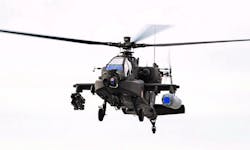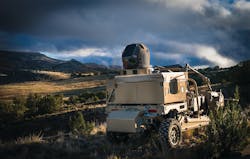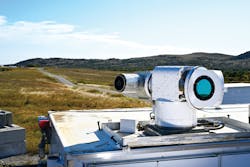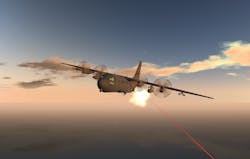Since the first laser was demonstrated in 1960, there has been speculation about and growing interest in using the technology as a weapon, starting in 1963 with a classified U.S. Department of Defense (DOD) conference to assess the military potential of lasers. For the following four decades, however, size, weight, and power (SWaP) were critical issues that prevented lasers from assuming a practical role in defense planning.
With sufficient resources, the chemical lasers of the time could generate enough power to damage a target, but only could be carried by the largest available platforms and, needing replenishment of the chemicals used, could only be fired for a limited time before returning to base.
In recent years, however, solid-state (SSL) and fiber lasers that include high energy lithium-ion batteries have made high-energy lasers (HEL) practical and potentially as ubiquitous in combat as unmanned vehicles. While Russia claims to have deployed operational lasers, there is no proof that any laser weapon system actually has been deployed as more than a prototype.
That, however, is about to change.
“The idea that this is 5 or 10 years away is no longer the case,” says Chris Frei, director of short range air defense at Northrop Grumman Corp. “In the fight, there tends not to be a ‘silver bullet,’ so the services are looking at a mix of different solutions, each with its strengths and weaknesses. So it is critical to have a system that can pull all that together so you can defend against 30 threats in the sky or a half dozen on the ground. Doing that gets the maximum effect out of any of these technologies.”
Evan Hunt, director of business development for high-energy lasers and counter-unmanned systems at the Raytheon Technology Corp. Intelligence & Space segment says he agrees.
“Laser weapons will be a core part of layered air defense employed by DOD and its coalition allies. That means laser weapons in any integrated system we have protecting serious assets in our territories. In five years, any large base that needs to defend its assets will have laser weapons, regardless of service.”
As for Russia’s claims, he adds: “Not all laser weapons are created equal. It’s easy to throw together a laser weapon and claim it is high power. You can buy lasers from industry, combine them on a truck. But for those who actually deal with targets as needed, it’s an entirely different scenario.”
Prototype lasers
Raytheon, Northrop Grumman, Lockheed Martin Corp. and others have been testing prototype lasers on Army Stryker combat vehicles, Navy ships, Air Forceplanes, and fixed facilities for all services for most of this century. Now, they say, many of those prototype demonstrators are ready to become programs of record, getting into the hands of warfighters in the next two or three years – perhaps sooner.
“Last October, we integrated the ATHENA — advanced tactical high energy asset — into an existing Army infrastructure and the Air Force Strategic Development and Training Office spent a day training two airmen, who then went against a number of different Class 1 and 2 UAV systems and we achieved greater than 88 percent effectiveness,” says Paul Shattuck, director of directed energy systems at Lockheed Martin Space Systems in Sunnyvale, Calif.
“We also networked an external radar into the command and control system,” Shattuck continues. “That was truly a full-up battlefield demonstration of the system, putting a prototype into a realistic operation and showing its effectiveness. We continue to mature our Spectral Beam Combined Fiber Laser technology to combine higher power lasers in a package that is smaller in size and weight with a higher conversion of electrical power in the light going out the laser. A lot of work also is ongoing in developing the control systems for laser weapons and in battle damage assessment.”
Industry experts won’t predict which service will deploy laser weapons as a standard part of their systems first, but the Army and Navy are moving forward quickly to place high-energy lasers into service as a major part of their air defense capabilities.
Navy efforts to develop solid state lasers include:
- Solid State Laser Technology Maturation (SSL-TM) effort;
- Optical Dazzling Interdictor, Navy (ODIN);
- Surface Navy Laser Weapon System (SNLWS) Increment 1, also known as the high-energy laser with integrated optical dazzler and surveillance (HELIOS); and
- High Energy Laser Counter-ASCM Program (HELCAP).
SSL-TM, ODIN, and HELIOS are part of the Navy Laser Family of Systems (NFLoS) effort, which, along with HELCAP and technologies developed by other parts of DOD, will support the development of future, more capable shipboard lasers.
HELIOS is undergoing system integration at Moorestown, N.J., home of the Aegis combat system, before going to Wallops Island, Va., for additional testing prior to its integration into an Arleigh Burke destroyer in 2021, where it will be built into the ship structure as well as being integrated into its Aegis system.
“HELIOS will provide an additional layer of protection for the fleet — deep magazine, low cost per kill, speed of light delivery and precision response. Additional HELIOS systems will accelerate the warfighter learning curve, provide risk reduction for future laser weapon system increments and provide a stronger demand signal to the supply base,” Brendan Scanlon, HELIOS program director at Lockheed Martin Rotary and Mission Systems, noted in a March news announcement.
Protecting ships
According to an April 2020 Congressional Research Service report to Congress — “Navy Lasers, Railgun and Gun-Launched Guided Projectiles” — lasers offer a significant improvement in the Navy’s ability to protect it ships against an enemy with a virtually unlimited number of missiles and swarming UAVs.
“The Navy in recent years has leveraged significant advancements in industrial SSLs and decades of research and development work on military lasers done by other parts of DOD to make substantial progress toward deploying high-energy SSLs on Navy surface ships. Navy surface ships would use high-energy SSLs initially for jamming or confusing (i.e., “dazzling”) intelligence, surveillance and reconnaissance (ISR) sensors, for countering small boats and UAVs and potentially in the future for countering enemy missiles, as well,” the report said.
“High-energy SSLs on Navy ships would generally be short-range defensive weapons — they would generally counter targets at ranges of about one mile to perhaps eventually a few miles. In addition to a low marginal cost per shot and deep magazine, potential advantages of shipboard lasers include fast engagement times, an ability to counter radically maneuvering missiles, an ability to conduct precision engagements and an ability to use lasers for graduated responses ranging from detecting and monitoring targets to causing disabling damage.”
However, the report continued, lasers are not a “silver bullet” protection against all threats or under all circumstances:
“Potential limitations of shipboard lasers relate to line-of-sight; atmospheric absorption, scattering and turbulence (which prevent shipboard lasers from being all-weather weapons); an effect known as thermal blooming that can reduce laser effectiveness; countering saturation attacks; possible adversary use of hardened targets and countermeasures and risk of collateral damage, including damage to aircraft and satellites and permanent damage to human eyesight, including blinding.”
Nonetheless, all of the services see lasers as future integral — and invaluable — components of an integrated, layered defense system for platforms, fixed sites and warfighters.
Battlefield lasers
In April, the Air Force Research Laboratory (AFRL) delivered the service’s first high-energy laser — Raytheon’s HEL Weapon System — for battlefield use against UAVs. Along with the Tactical High Power Operational Responder (THOR), it will undergo a one-year overseas assessment.
“The fact that it’s a laser weapon allows you to put energy on target at the speed of light. It can be an instantaneous heating event,” Michael Jirjis, head of the Air Force’s directed energy experimentation projects, said at the time.
“THOR is a directed energy game-changer,” AFRL directed energy Director Kelly Hammett added in the same AFRL news release. “Drones are becoming moreand more pervasive and can be used as weapons intended to cause harm to our military bases at long standoff ranges. We built the THOR weapon system as a deterrent against these type threats. THOR, with its counter electronic technology, can take down swarms of drones in rapid fire. This capability will be an amazing asset to our warfighters and the nation’s defense.”
The Army is fielding a Stryker-mounted 50-kilowatt laser, with deployment planned for 2022, to defend warfighters against UAVs, rockets, artillery and mortars. Rather than following that with a 100-kilowatt high-energy laser, however, the Army now is looking at a 250-to-300-kilowatt component to its Indirect Fire Protection Capability (IFPC), intended to counter cruise missiles. Officials say that HEL-IFPC system should be available to warfighters by 2024.
“The advantage of the laser is that we have the ability to have an unlimited magazine when it comes to unmanned aerial systems, as well as rockets, artillery, mortars,” Lt. Gen. Paul Ostrowski, principal military deputy to the Assistant Secretary of the Army for Acquisition, Logistics and Technology, said last year. “Where before we were shooting $100,000 missiles at $7,000 UAVs, this puts us in a position where we’re not spending that kind of money to do that. We’re taking those targets down in a much more rapid fashion and a much cheaper fashion.”
Special Operations also has a strong interest in laser weapons, as demonstrated by the Air Force Special Operations Command’s (AFSOC) efforts to integrate a 60-kilowatt laser aboard the AC-130J Ghostrider gunship.
“The goal is to provide an armed overwatch capability using directed energy,” AFSOC commander Lt. Gen. James Slife said at the Air Force Association’s Air, Space and Cyber Conference last year. “The testing of that and the integration work that is ongoing is all proceeding at pace. We haven’t seen anything up to this point that would lead us to believe that is not all achievable in the near-term time horizon that we’re working against.”
Enabling technologies
From championship car racing to medicine to computer gaming to increasingly computerized household products, laser weapons have benefitted from wide and diverse sources of new technology.
“One of the enabling technologies is electric lasers and the fiber lasers. That has been a real revelation and one of the keys to our packages of laser weapon systems,” says Lockheed Martin’s Shattuck. “At the dawn of laser weapons, you were talking about chemical lasers, which were huge systems with quite a logistics footprint. The next generation was probably half as efficient. Fiber lasers are two to three times more efficient than that, so the power and thermal requirements are half to one-third what they were. The advent of being able to scale fiber lasers up to hundreds of kilowatts has been a major advance.
“Also impacting those systems are improvements in computing, a lot of it coming from the gaming arena, where the commercial market is driving improvements in size and processing power and allowing for very advanced algorithms for tracking targets, such as UAVs that maneuver and fly in cluttered backgrounds.”
The future, he adds, will see a continuation of those synergies:
“You’ll see a continued development of the laser diode, with more compact packages and higher power, improvements in putting more power through fiber. There also will be continued development in the processing power we need for optics, coding, algorithms. With optical coding, some of the preeminent coding providers today were coding smaller optics, primarily for medical use. There will continue to be synergy between military and commercial. The whole advent of AI and machine learning also will continue to evolve and find its way to better determine what targets to go after, what’s the optimum beam point, etc.”
In the near-term, Raytheon’s Hunt says laser weapons technology is making rapid progress.
“We are in a mature prototype phase, a technology transition phase, where we have finally developed laser weapons with operational, proven capability against asymmetric threats, such as Class 1 and 2 drones. Those are being tested in operational environments and will inform programs of record. That’s also true for 50-kilowatt weapons, such as the one we’re building for the Army on a mobile platform for other targets than just drones,” he says. “Laser weapons are really on the verge of moving to production programs for operational use in the air defense category, from 10-to-50-kilowatt for short range air defense, typically within 10 kilometers.
“The laser weapon is part of a layered defense approach. For larger, long-range threats, you’ll still rely on kinetic weapons,” Hunt continues. “Close-in, laser weapons are very precise and capable, reducing collateral damage. They don’t create large explosions or shrapnel. They’re also silent and invisible, so they are not disruptive. The second you start affecting the target, you get real-time damage assessment, so you have almost no chance of missing the target and hitting something you don’t intend to.”
Leveraging commercial lasers
Hunt notes the synergistic nature of military and commercial lasers and support systems has added to the speed of development and system capability.
“All of the laser weapons technologies have matured to the point where we are ready to integrate them into the field. One is the E/O sensor. At Raytheon, we use a multi-spectral system we have used on the ground and in the air that enables us to get the laser beam on the precision point we need to be effective,” he says.
“Another is advanced lithium batteries,” Hunt says. “There is no way to store a direct run from ground power, so now we have batteries that make power available on demand. There have been advances in the fiber laser arena, which are compact, clean and efficient. We use those modules, modified for defense use, and combine them to create our laser power. And finally, frankly, video game technology for integrated training. We use a single laptop as the interface and games that can help us train users in just a couple of hours.”
Several laser technologies are being tested for the next generation of systems.
“There are competing technologies — fiber, DPALs [diode-pumped alkali lasers], distributed lasers, etc. That is part of the current effort for the 300-kilowatt development, to see which of these technologies will come to the front,” says Dennis Hammons, Director of Strategy and Capture-Directed Energy at Northrop Grumman.
“A key part of the enabling technology has been electric driven lasers, currently fiber. High brightness and low cost are other aspects. In combining these lasers to make higher power systems is multilayer dielectric grating, which was initiated by Lawrence Livermore. Other key aspects are more in the realm of how we identify, track and maintain aim point on the target and how we reduce jitter in the system for line-of-sight stabilization.”
America’s allies also are moving forward rapidly with laser technology for defense. In January, for example, Israel’s Ministry of Defense (MOD) announced a major achievement in a high-energy laser effort by the Directorate of Defense Research and Development (DDR&D). According to an MOD release, the effort will produce a system able to precisely focus laser beams on long-range targets, overcoming atmospheric disturbances, adding new capability to Israel’s four-layer air defense system.
“The new technology will prompt a strategic change in Israel’s defense capabilities. Throughout the year 2020, we will conduct a demo of our capabilities,” an MOD release said, then quoted DDR&D chief Brig. Gen. Yaniv Rotem as saying, “We are entering a new age of energy warfare in the air, land and sea.”
Efforts in Europe
Europe also is working to field laser weapons sometime in the 2020s. The Tactical Advanced Laser Optical System (TALOS), backed by the European Defense Agency, could lead to fielding laser weapons with European forces by 2027, says Antoine Bouvier, former CEO of defense manufacturer MBDA in Le Plessis-Robinson, France.
In the United Kingdom, meanwhile, the Defence Science & Technology Laboratory (DSTL) is working with British industry and the U.S. Navy, under the Advanced Electric Power and Propulsion Project Arrangement, to develop future energy storage options for British warships to power the next generation of naval laser weapons. Related to that, DSTL and GKN Aerospace in Redditch, England, developed the Flywheel Energy Storage System (FESS), using high-speed, lightweight flywheels to provide high-power electric pulses.
In testing FESS, the U.S. and United Kingdom teams used power hardware-in-the-loop (PHIL) to integrate FESS into a virtual ship power architecture emulating real-time Royal Navy operations.
“This project gave us a great opportunity to showcase the PHIL test-bed that we’ve developed at PNDC,” program technical lead Kyle Jennett said in a United Kingdom MOD statement. “This test bed lets us connect real-world hardware, like the FESS, to simulated naval platforms to evaluate the impact on the ship during different operational scenarios.”
Government officials say they hope this technology will smooth the way for integration of next-generation weaponry onto naval vessels, including the United Kingdom Dragonfire, being developed by DSTL and United Kingdom industry as part of the laser directed energy weapon capability demonstrator program.
Fielding a fully operational laser weapon would require advances across a complex range of technologies, many of which are ready — or nearly so — for deployment. But the first generation of such weapons will go to the warfighter with demands for greater and greater capability.
Need for power
“Everybody wants more laser power. If you build the weapon correctly, then more power equates to longer range and kill capability for larger targets. But it’s not that simple. You also have to be able to direct that more powerful beam on a precise point at a long range and package it in a configuration that is viable to the warfighter; 50-kilowatt gets you on a vehicle such as Stryker, but more power means larger platforms as costs and lead times go up,” Hunt says.
“Certainly we will continue to advance laser power, but it makes sense to get 10 and 50-kilowatt systems into the field quickly, then we can start stepping up accordingly and begin providing air-to-ground capability, using the same core components we have on the MRZR for next-generation rotor platforms for the Army and U.S. Special Operations Command,” Hunt continues.
“Adjacent applications for high-energy laser are power beaming to recharge something at very long range. That also applies to laser communications. The hope is that in the long run, the laser is not just a replacement for kinetic effectors. In some cases, it won’t do things as well as missiles, but it will fill a gap in short-range defense and, eventually, to longer range targets.”
The U.S. military will move from deployed prototype demonstrators to programs of record on a variety of defensive lasers across all services far more quickly than the general public may expect.
“In the next five years, we’ll see operational systems being deployed on ships, land vehicles, in fixed emplacements and potentially airborne. The current generation of demonstrators and prototypes are consistent with the acquisition strategies of OSD and, I believe, will be the first generation of laser weapons to be operationally deployed,” predicts Lockheed Martin’s Shattuck.
“Over decades I’ve watched the development of these technologies and it’s been good to see the maturity of the overall laser weapons systems and have utility for specific warfighter gaps. One of the enablers is the maturity of these systems compared to the warfighter gaps. It’s not a technology in search of a use, but a technology that clearly offers precision, deep magazines, lower costs per shot and a lot of advantages as you look at potential future concepts. It is not a do-all, but is designed to basically provide a layer in an overall defensive system.”






